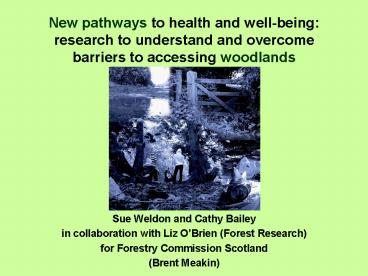Sue Weldon and Cathy Bailey - PowerPoint PPT Presentation
1 / 15
Title:
Sue Weldon and Cathy Bailey
Description:
... q q q q q q q q q q q q q q q q q q q q q q q q q q q q q q q ... OLYMPUS DIGITAL CAMERA OLYMPUS IMAGING CORP.FE190/X750yH*H*Version 1.02007:04:26 ... – PowerPoint PPT presentation
Number of Views:32
Avg rating:3.0/5.0
Title: Sue Weldon and Cathy Bailey
1
New pathways to health and well-being research
to understand and overcome barriers to accessing
woodlands
- Sue Weldon and Cathy Bailey
- in collaboration with Liz OBrien (Forest
Research) - for Forestry Commission Scotland
- (Brent Meakin)
2
The research aims
- To understand the barriers affecting peoples
access to woodlands and forests for health and
well-being - To identify, prioritise and promote potential
opportunities to overcome these barriers
3
Environmental Inequalities
- Environment are shaped by social, cultural and
political factors - Inequalities are written into the landscape (the
Forestry Commission is part of the story) - Bringing together social inclusion and
environmental equity for sustainable communities
(Scottish Executive sustainability strategy
Choosing our Future (2005))
4
Background to the research
- Community regeneration Closing the Gap
(Scottish Executive, 2002) - Scottish Physical Activity Strategy 'Let's Make
Scotland More Active' (Scottish Executive, 2003) - Land Reform Act (2003)
- Scottish Forestry Strategy (Forestry Commission
Scotland, 2006)
5
How we approached the research
- Action research in context of local
action/access provision - Case Studies 5 case studies in Scotland
6
Case Studies
Locality Project Community Group Woodland activity
Motherwell Urban Greenlink Mother and toddler group Guided buggy walk
Drumchapel Urban WIAT/community woodland Older people attending a Day Care Centre Guided Health walk
Dundee Urban TWIG Youth group (youth café) Cycling activities
Galashiels Semi- rural WIAT/Borders Forest Trust Young men seeking paid work Building and installing bird/bat boxes
Ardnamurchan Rural Sunart Oakwoods project Rural community (mixed group) No organised activity (participant observation within the community)
7
Known issues affecting access
- Lack of knowledge
- Lack of motivation
- Lack of time
- Physical accessibility
- Lack of physical fitness
- Feeling unwelcome
- Lack of reasonable facilities
- Conflicts of use
- Negative perceptions, fears and safety concerns
8
Our research findings
- Similar sets of issues BUT experienced
differently in different contexts why do people
feel unsafe? Why do people feel unwelcome? What
sorts of knowledge do they need? - Is it relevant? (i.e. is it possible to engineer
access without community participation?)
9
Its a wider problem
- Youre talking about us right? But its a
wider problem, its no just about us and our
young kids. Teenage kids as well, thats why
theyre hanging aboutcos they dont have
anything else to do either. So the problem
doesnae just lie with us going out country
walking and things like that. They dont have a
facility or anywhere organised to get teenage
kids organised into it. (mothers, Motherwell)
10
Context for access
- Walking in woodland (e.g. Paths to Health)
- Volunteering in woodland (e.g Green Gym)
11
Urban areas health walks
- Leg it around Drumchapel
- Health walk for older people (Drumchapel)
- A buggy walk for young mothers (Motherwell)
12
Rural areas health walks
- A wee walk and a blether (Ardnamurchan)
13
Urban areas volunteering
- Maintaining access
- Clearing rubbish
- Volunteering as a route into paid work
(Galashiels, Drumchapel Greenwork mates) - Its someone elses job (Motherwell, mothers)
14
Rural areas volunteering
- A rural necessity
- Community ownership
- Facilities created for, and by, the community
(Sunart Oakwoods project)
15
Environmental/social inequalities a comparison
- Urban access issues
- Unsafe environment - associated with crime and
anti-social behaviour - Unpleasant environment -litter, damage and
pollution - Social deprivation unemployment, poor housing,
crime youths hang out in local woods
- Rural access issues
- Unsafe environment - associated with lack of safe
access to services environments (busy country
roads) - Pleasant environment but access not actively
welcomed on private land - Social deprivation lack of employment, lack of
affordable housing, lack of services young
people forced to leave the area



























![⚡Read✔[PDF] Marsupial Sue Book and CD PowerPoint PPT Presentation](https://s3.amazonaws.com/images.powershow.com/10058598.th0.jpg?_=202406190611)



